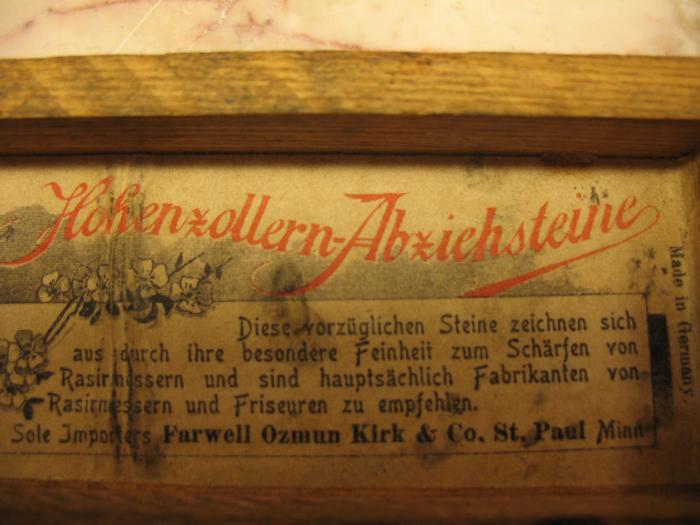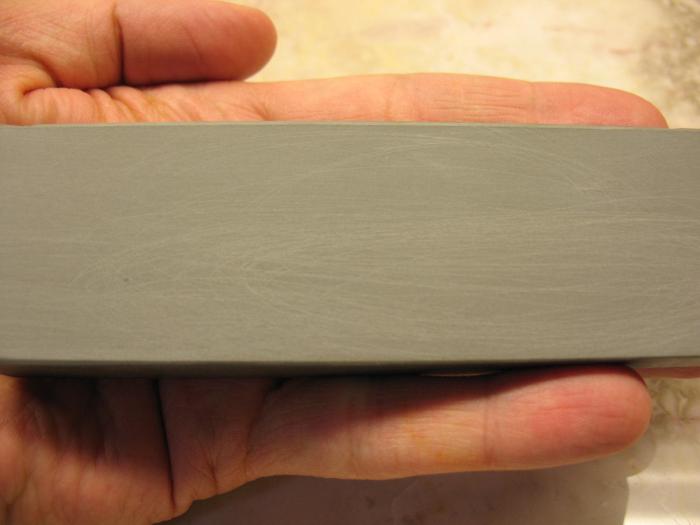Results 101 to 110 of 197
Thread: Dragons Tongue Hone anyone?
-
01-31-2009, 01:48 AM #101


+1 !! To quote a blues song by Ry Cooder, "It's a slow consumption killing me by degrees".
From literature I have read it first appeared to me that the Tam and the Water of Ayr were one and the same but I have since found out that they are quite different.
I have a Droescher that looks very like your stone. When it is dry it looks like an Escher blue/green but wet it turns silky black. The slurry is milky. A nice finisher.Be careful how you treat people on your way up, you may meet them again on your way back down.
-
01-31-2009, 02:04 AM #102
-
01-31-2009, 02:12 AM #103
 Be careful how you treat people on your way up, you may meet them again on your way back down.
Be careful how you treat people on your way up, you may meet them again on your way back down.
-
01-31-2009, 02:16 AM #104
-
01-31-2009, 02:48 AM #105

Where did you get the Hohenzollern, Jimmy? Personally I would refer to that hone as a Hohenzollern rather than Droescher. I owned a Hohenzollern but rather than Droescher, the retailer was a hardware company in St. Paul, MN called Farwel Ozmun Kirk. Kees owns mine now. He says his Hohenzollern performs better than his best Eschers IIRC. Hohenzollern would be akin to the make of an auto while Droescher or Farwel Ozmun Kirk would be akin to the dealership. Just my opinion.



 My fellow HADdicts will forgive me I'm sure.
My fellow HADdicts will forgive me I'm sure.
Chris L"Blues fallin' down like hail." Robert Johnson
"Aw, Pretty Boy, can't you show me nuthin but surrender?" Patti Smith
-
01-31-2009, 03:25 AM #106

I guess you are right Chris. OTOH, a mutual HADICT refers to it as a Droecsher because of the signature while Hohenzollern is the geographical area. At least I think it is with the castle and all on the label ? One way or the other it is a good rock. I wish I had been up on them when you sold that y/g. I might have beat Kees to the punch.
 Be careful how you treat people on your way up, you may meet them again on your way back down.
Be careful how you treat people on your way up, you may meet them again on your way back down.
-
01-31-2009, 03:41 AM #107

I see your point, Jimmy. Well, it's all Thuringian to us!

Chris L"Blues fallin' down like hail." Robert Johnson
"Aw, Pretty Boy, can't you show me nuthin but surrender?" Patti Smith
-
01-31-2009, 07:25 PM #108Senior Member

- Join Date
- Aug 2006
- Posts
- 882
Thanked: 108
The short answer is yes. The long answer is....it's complicated.
Both come from the same area, Ayrshire, and were mined and packaged by the same company. The Tam O'Shanter is mottled beige-gray in appearance. Traditionally it was for jewelers and watch-makers. It's rated as "fine" by the company and most guys here rate it about 6-8K. It is good for gentle honing on microchip-prone razors, and many guys find that if you use it before a higher-grit finisher the end result will be very smooth & comfortable. Not many shave directly off of it.
The Water of Ayr is charcoal-gray to black and homogenous in appearance. It looks and feels like a black escher. Traditionally it was for razors and scalpels. It is rated as "very fine" by the company and in my experience is comparable to the coticule and chinese 12K. I'm not good at estimating grits but you can shave off it very nicely. It feels like silky glass to hone on.
The same company also sold other natural stones including the Dalmore Yellow and the Dalmore Blue. The name of the company was the "Water of Ayr Hone Works" or something like that. The Tam O'Shanter is by far the most famous & commonly found of the stones they made, but it wasn't always called that; hence the confusion. In the 19th and early 20th century what we now call the "Tam O'Shanter" was variously called "Snakestone," "Scotch hone," and "Water of Ayr stone." In the early 20th century, the company announced that thenceforth the famous mottled beige stone would be known as the "Tam O'Shanter," and at that point the name "Water of Ayr" would be reserved for the finer, scarcer dark stone. "Dalmore Blue" and "Dalmore Yellow" were also introduced as names for the medium and course stones, respectively.
I once found the company's announcement in an old trade journal (via Google Books); I'll see if I can find it again.
This is the reason there is sometimes confusion about naming. The Tam O'Shanter still gets called the "Water of Ayr stone" quite a bit, not only in old books referencing it but also by online merchants still selling it. If you're about to buy a "Water of Ayr stone" from an online seller and what you want is the very fine dark finishing stone, ask them to describe it.
To add extra confusion, I believe that at the time of its announcement, the company changed its name to "Water of Ayr and Tam O'Shanter Hone Works."
I read somewhere – again, I'll try to find it – that the origins of the dark Water of Ayr Stone is petrified wood!Last edited by dylandog; 01-31-2009 at 07:27 PM.
-
01-31-2009, 07:55 PM #109Senior Member

- Join Date
- Aug 2006
- Posts
- 882
Thanked: 108
I found the company announcement (a paid notice John C. Montgomerie, the owner of the company at the time, took out in "Kelly's Directory of the Leather Trades" in 1885) and a related comment of mine from an old thread:
Here are a couple pics of a Tam O'Shanter / Water of Ayr combination stone:
-
-
01-31-2009, 08:35 PM #110

 fantastic, thanks so much for sharing that, brilliant information, this thread gets better and better, thanks to everyone who has contributed so far.
fantastic, thanks so much for sharing that, brilliant information, this thread gets better and better, thanks to everyone who has contributed so far.
Ive been googling and asking around for further info on the welsh hone stones, particularly the so called greenstone which intrigued me and which may or may not be any good at all for razors. It did sound like an igneous rock which would be unlikely for a hone and I wasnt getting very far at all, then I chanced upon this in an 1866 journal pertaining to the geology of Snowdonia that just happened to be scanned online
-------------------------------------------------
Greenstones. I shall now explain in detail the mode of occurance of the greenstone rocks on and around Snowdon,
These have heretofore only been incidentally alluded to. They are intrusive and excepting a few narrow dykes, they are of lower silurian age. It is needless to describe each one; but a few of the principal masses may specially noticed. All of them are hornblendic. Between Pen-Y-Gwryd and Cribiau five patches pierce the stratified rocks and the overlying felspathic porphery. They lie about the same level with those near Dolwyddelan and Moel Siabod, are dark green, and distincly but not largely crystalline, hornblende predominating, and they alter the rocks with which they are in contact.
The line of greenstone about a mile in length that passes through Llyn-Y-Cwm-ffynnon is well crystallised, slightly branching at its south east end where the slaty rocks in contact with it are altered, and quarried for hone stones.
------------------------------------------------------
So I have a location and from this I am going to guess that the greenstones are not green stone at all but slate that was adjacent to and metamorphosed by the greenstone
Last edited by Jason01; 01-31-2009 at 08:39 PM.


 9Likes
9Likes LinkBack URL
LinkBack URL About LinkBacks
About LinkBacks









 Reply With Quote
Reply With Quote Maybe one of the mods will let us know.
Maybe one of the mods will let us know.
